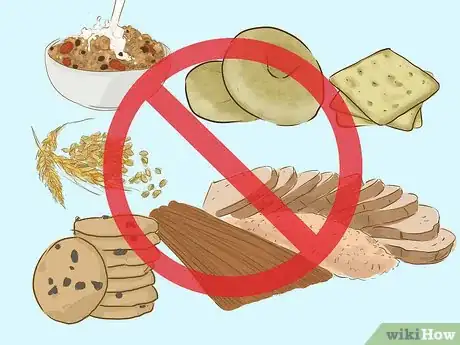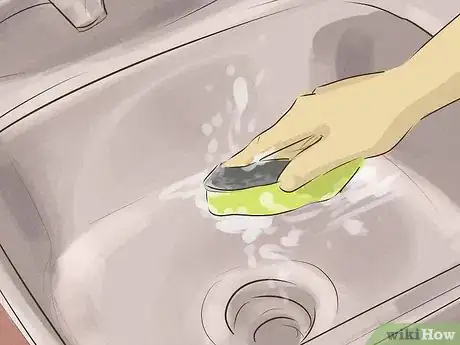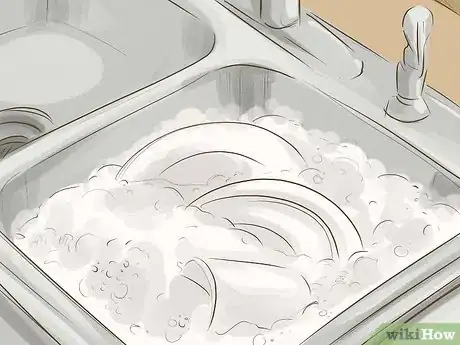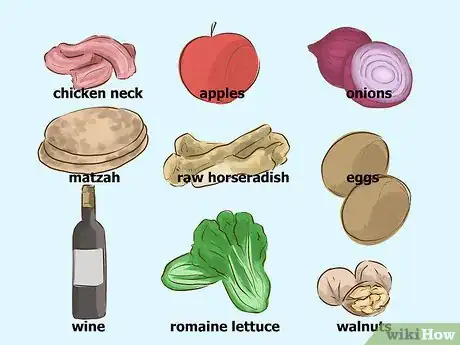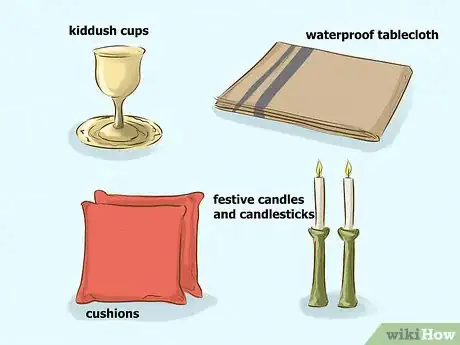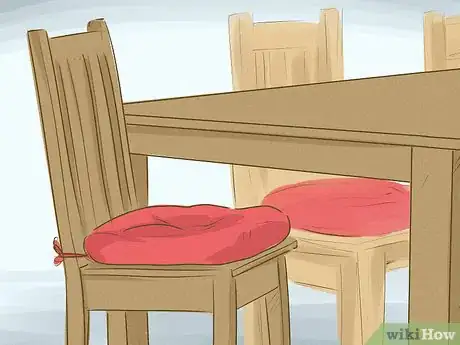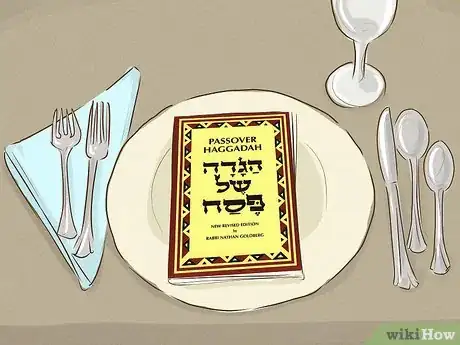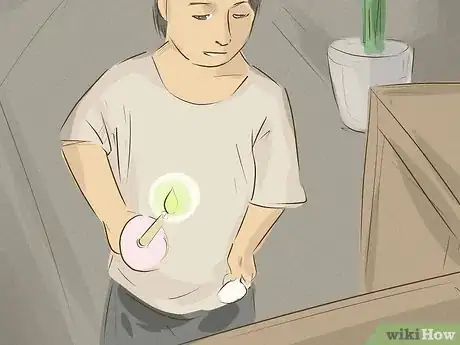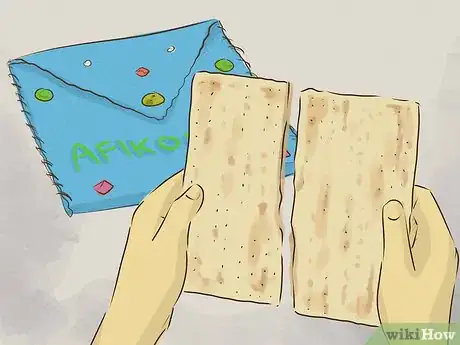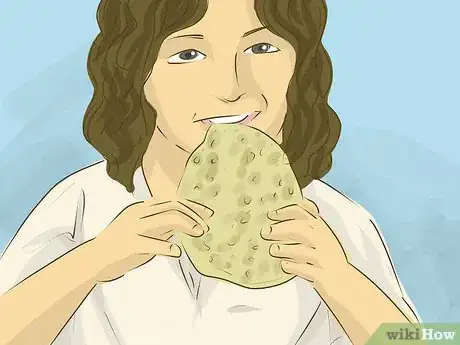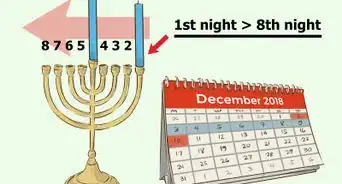This article was co-authored by wikiHow Staff. Our trained team of editors and researchers validate articles for accuracy and comprehensiveness. wikiHow's Content Management Team carefully monitors the work from our editorial staff to ensure that each article is backed by trusted research and meets our high quality standards.
There are 12 references cited in this article, which can be found at the bottom of the page.
This article has been viewed 20,796 times.
Learn more...
Passover, called Pesach in Hebrew, is an eight day festival beginning on the 15th and ending on the 22nd of the Hebrew month of Nissan. Preparing for Passover and its many traditions can seem daunting, but it doesn’t have to be. The basics, like cleaning your home and removing any trace of chametz can be done in advance. Keep a checklist so you can feel the satisfaction of marking off each task as it’s completed. Before you know it, you’ll be celebrating the holiday surrounded by family and friends!
Steps
Preparing Your Home
-
1Clear your calendar. The first and last two days of Passover are considered holidays, and work is forbidden. The use of electronic devices, writing, and driving are also off-limits. Work related to preparation and/or attendance of the Passover and Seder is permitted. The principle idea behind this is that you relax, enjoy, honor, and celebrate the holiday.[1]
- Consult your rabbi or a Hebrew calendar to find out when the Passover falls each year.
- The four days in the middle, called Chol Hamoed, are not official holidays and most work and activities are allowed.[2]
-
2Remove or “sell” chametz. One of the most important preparations you’ll make is to throw out or otherwise dispose of any chametz, which is leavened grain product. Throughout Passover, no one in your family should consume or use any product with chametz, including bread, cereal, pasta, and most types of alcohol. This even includes pet food and other products that contain any trace of wheat, rye, barley, oats, or spelt.[3]
- Some people “sell” their chametz products to a non-Jewish friend or neighbor and buy them back after Passover. This can also be done on the internet! Alternatively, you could donate them to charity or try to use them up well before Passover begins.[4]
- In the Ashkenazi community, it is also advised to avoid rice, millet, corn, mustard, and legumes.[5]
Advertisement -
3Clean your home. Pay special attention to the kitchen and any areas where food is consumed. It’s customary to begin this process weeks in advance and expected that your refrigerator, microwave, toaster, and oven will be cleaned inside and out to destroy any leftover traces of chametz. Then follow up by searching every other room in your home and cleaning those top to bottom.[6]
-
4Sterilize your utensils, serving dishes, and cookware. According to kosher-for-Passover guidelines, your utensils, dishes, cookware - basically anything that you’ll be using to prepare or serve your Seder plate or Passover meals - need to be sterilized by putting them in boiling water or heating them up to a red hot glow.[7]
Shopping for Passover and Seder
-
1Shop for kosher-for-Passover foods. Fruits, vegetables, most dairy products, and kosher cuts of meat, poultry, and fish are approved for Passover as long as they have not touched chametz. Matzah and wine are staples of Seder and are often consumed throughout Passover. Some packaged foods may be available at the grocery store and marked kosher-for-Passover.[10]
-
2Shop for Seder. If you are hosting Seder, you’ll be preparing a symbolic plate with several ingredients. Purchase matzah, chicken neck, eggs, raw horseradish, romaine lettuce, apples, walnuts, wine, and onion. You’ll also need enough wine for each person to have four glasses.[11]
- Alternative recipes include pears in the charoset, and some people use beef or lamb bones instead of chicken necks. Rather than an onion, some folks use potato. Grape juice is a suitable alternative for wine.[12]
-
3Purchase or print the Haggadah. You can download it for free online here: http://www.chabad.org/holidays/passover/pesach_cdo/aid/661624/jewish/English-Haggadah.htm, or purchase copies from a book store. Your synagogue may have copies you can have or borrow. However you acquire them, it’s a great idea to have several copies.[13]
-
4Shop for table accessories. Commonly used items include festive candles and candlesticks, kiddush cups, and a waterproof or washable tablecloth (just in case those glasses of wine end up somewhere other than the mouth).
- You may also want to purchase pillows or cushions for each person to sit on, and some games and prizes for the children attending the ceremony. Try legos, coloring supplies, or sculpting clay to keep them occupied.[14]
Setting up for Seder
-
1Set the Passover table. If you are hosting Seder, your dining table is the centerpiece of your service and meal. It’s also an opportunity for you to be creative and start your own traditions. At a minimum, you’ll want to include:[15]
- Tablecloth and napkins
- Kosher-for-Passover dishes, flatware, and water glasses
- Kosher-for-Passover wine glasses
- Small kosher-for-Passover dishes of salt water for dipping
- A special kiddush cup for your Seder leader
- Two kiddush cups in the center, which symbolize the presence of Moses’ sister, Miriam, and Elijah
- Festive candles
-
2Place cushions on each chair. This symbolizes the freedom earned by the Israelites and will help your guests stay comfortable during the service.[16]
-
3Place a copy of the Haggadah at each table setting. Your guests will be able to follow along as the leader of the service recites the stories and rituals.[17]
-
4Lay out the food for the Seder plate(s). The seder plate contains six symbolic foods. Some foods need to be cooked and others will just need to be placed on the plate.[18] The foods are:
- Matzah - place three pieces, covered, on a separate plate.[19]
- Zeroa (shankbone) - some folks use the forearm of a lamb or a roasted chicken neck. It is not eaten at the Seder and can be used again the next night.[20]
- Hard-boiled egg - to be eaten during the Seder.[21]
- Maror (bitter herbs) - to be eaten during the Seder. Raw, grated horseradish and romaine lettuce are most commonly used.[22]
- Charoset (paste) - a mixture of pears, apples, wine, and nuts. This acts as a relish for the maror.[23]
- Karpas (vegetable) - typically parsley, onion, or boiled potato. The vegetable is dipped in saltwater as a way to remember the tears of the Israelites.[24]
-
5Place the Seder plate(s). The Seder plate should be placed in front of the leader of the service. It doesn’t really matter what dish you use for the plate, so long as it’s kosher-for-Passover. Many people use a special plate just for this purpose. If there are multiple tables, make and place multiple plates so that guests have easy access.[25]
Performing Rituals
-
1Complete the search for chametz. Called bedikas chametz in Hebrew, searching for chametz is an important and fun way for families to ensure that no chametz has sneakily survived in the home.[26] It’s usually done the night before Passover begins, and sometimes by candlelight. A special blessing and recitation completes the ritual.[27]
- Some folks choose to hide 10 pieces of chametz in the house and then find them during this ritual. As long as you remember where you put them, it can add extra fun for the kids![28]
-
2Learn the four questions. During Seder, four questions from the Haggadah are to be asked, usually by the youngest child. Although the questions are supposed to be spontaneous, they are also a required part of the service. Decide in advance who will ask the questions and who will respond with the answers. The four questions are:[29]
- Why do we eat unleavened bread?
- Why do we eat bitter herbs?
- Why do we dip our food in liquid?
- Why do we eat in a reclining position?
-
3Hide the afikoman. Before the Passover Seder begins, hide the middle piece of matzah from the three pieces that are served with the Seder plate. You can also hide several pieces, if you have several children attending.[30]
-
4Search for the afikoman dessert. Tell the children about the search, and explain that you’ll be awarding prizes to whoever finds a piece. They will usually get a huge kick out of this and it will keep them entertained! This should be done before midnight, according to tradition. Once found, award the prizes and consume the afikoman as your dessert![31]
References
- ↑ https://www.chabad.org/holidays/passover/pesach_cdo/aid/871715/jewish/Passover-Pesach-2017.htm
- ↑ https://www.chabad.org/holidays/passover/pesach_cdo/aid/871715/jewish/Passover-Pesach-2017.htm
- ↑ https://oukosher.org/passover/articles/observing-passover-holiday/
- ↑ http://www.bbc.co.uk/religion/religions/judaism/holydays/passover_1.shtml
- ↑ https://www.chabad.org/holidays/passover/pesach_cdo/aid/1783/jewish/Passover-Shopping.htm
- ↑ http://www.jewishvirtuallibrary.org/passover-history-and-overview
- ↑ https://www.chabad.org/holidays/passover/pesach_cdo/aid/117233/jewish/Koshering-Utensils-for-Passover.htm
- ↑ https://www.chabad.org/holidays/passover/pesach_cdo/aid/117233/jewish/Koshering-Utensils-for-Passover.htm
- ↑ http://www.jewishvirtuallibrary.org/preparing-for-passover
- ↑ https://www.chabad.org/holidays/passover/pesach_cdo/aid/1783/jewish/Passover-Shopping.htm
- ↑ http://www.jewishvirtuallibrary.org/preparing-for-passover
- ↑ http://www.chabad.org/holidays/passover/pesach_cdo/aid/1998/jewish/The-Seder-Plate.htm
- ↑ http://www.chabad.org/holidays/passover/pesach_cdo/aid/1825/jewish/Passover-A-to-Z.htm
- ↑ http://reformjudaism.org/jewish-holidays/passover/hosting-passover-seder-use-checklist-prepare
- ↑ http://reformjudaism.org/jewish-holidays/passover/hosting-passover-seder-use-checklist-prepare
- ↑ http://reformjudaism.org/jewish-holidays/passover/hosting-passover-seder-use-checklist-prepare
- ↑ http://www.chabad.org/holidays/passover/pesach_cdo/aid/1825/jewish/Passover-A-to-Z.htm
- ↑ http://www.chabad.org/holidays/passover/pesach_cdo/aid/1998/jewish/The-Seder-Plate.htm
- ↑ http://www.chabad.org/holidays/passover/pesach_cdo/aid/1998/jewish/The-Seder-Plate.htm
- ↑ http://www.chabad.org/holidays/passover/pesach_cdo/aid/1998/jewish/The-Seder-Plate.htm
- ↑ http://www.chabad.org/holidays/passover/pesach_cdo/aid/1998/jewish/The-Seder-Plate.htm
- ↑ http://www.chabad.org/holidays/passover/pesach_cdo/aid/1998/jewish/The-Seder-Plate.htm
- ↑ http://www.chabad.org/holidays/passover/pesach_cdo/aid/1998/jewish/The-Seder-Plate.htm
- ↑ http://reformjudaism.org/jewish-holidays/passover/hosting-passover-seder-use-checklist-prepare
- ↑ http://reformjudaism.org/jewish-holidays/passover/hosting-passover-seder-use-checklist-prepare
- ↑ http://www.aish.com/h/pes/l/48969586.html
- ↑ http://reformjudaism.org/jewish-holidays/passover/hosting-passover-seder-use-checklist-prepare
- ↑ http://reformjudaism.org/jewish-holidays/passover/hosting-passover-seder-use-checklist-prepare
- ↑ http://www.bbc.co.uk/religion/religions/judaism/holydays/passover_1.shtml
- ↑ http://reformjudaism.org/jewish-holidays/passover/hosting-passover-seder-use-checklist-prepare
- ↑ http://reformjudaism.org/jewish-holidays/passover/hosting-passover-seder-use-checklist-prepare
About This Article
To prepare for Passover, first remove or "sell" anything in your home that includes chametz, like bread, pasta, and most types of alcohol. While some people will toss these things, donate them, or really try to sell them, many others will simply "sell" their chametz products to a friend before Passover, then buy them back afterward. You should also clean your home, paying special attention to the kitchen, and sterilize the utensils, serving dishes, and cookware you plan to use for Passover. If you are hosting Seder, you'll need table accessories like kiddush cups and festive candles, as well as wine, matzah, and chicken neck or lamb. For more advice, like how to set up for Seder, read on!

